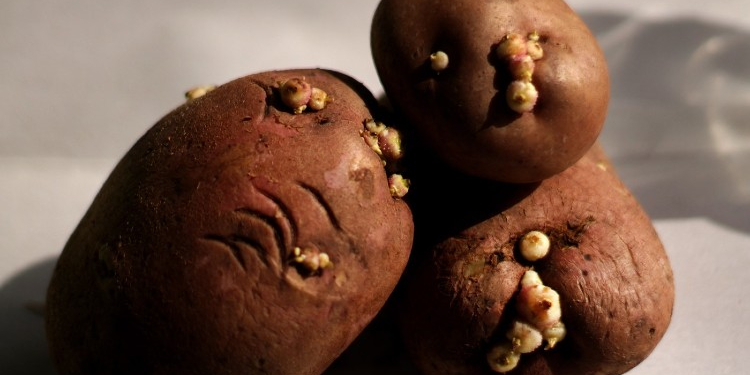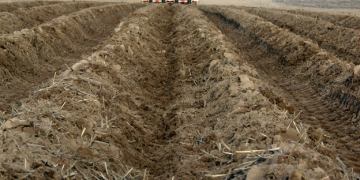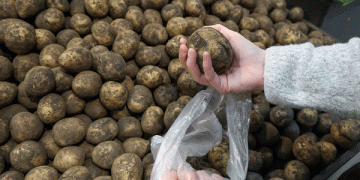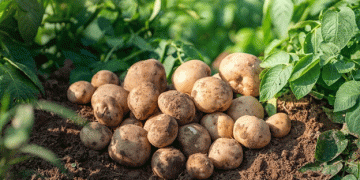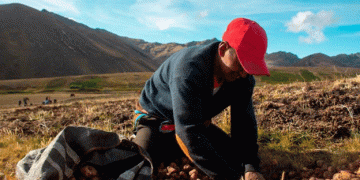A recent paper in the journal Potato Research highlights the chlorpropham (CIPC) ban and the weaknesses and limited sustainability of global and local systems based on synthetically produced substances. But what are the current alternatives to CIPC? This article summarizes the findings of an Agroscope study of alternative sprout inhibitors. It includes a Michigan State University researcher’s analysis of this study.
Challenges caused by the ban on CIPC in Europe
Opportunities and Challenges in Sustainable Agri-food Systems is a review paper published in Potato Research, journal of the European Association for Potato Research (EAPR). Among others, the paper examines how to produce as much as possible with as little waste as possible through value chain development and better post-harvest management.
According to the authors of the paper, food systems must change in the future if the world’s growing population is to be fed properly. One of the challenges will be to produce more food with the same or fewer resources and less waste. The potato crop can meet this challenge because it has demonstrated it can reduce hunger globally and improve household incomes during crises such as the current rate of global population growth.
But to produce the same volume of potatoes and at the same time reduce the waste caused by processing for example, value chain development and improved post-harvest management will be needed. This is where potato producers and the processing industry are having a hard time. It is critically important for the processing industry to develop new sustainable technologies to ensure the availability of raw product all year round.
The chlorpropham (CIPC) ban in Europe is causing significant technical and financial challenges because of the high cost of and fairly limited knowledge about alternative anti-sprouting solutions.
CIPC has been proven over time to be an effective and inexpensive sprout inhibitor, in use since 1959 by the potato industry. Growers usually apply it in large potato storage facilities and shipments destined for export. Thanks to the use of CIPC, it was possible to supply markets year-round with fresh and processing material, and export to distant destinations have always been relatively easy as far as the danger of enroute sprouting was concerned.
Due to data gaps in the CIPC registration renewal application file and the increased consumer concern about a potential risk of this compound and its main metabolite 3-chloroaniline, the European Union has decided not to allow the renewal of CIPC for use as spout suppressant in potato storages.
Several products can potentially replace it – and some are in use already – but most need to be applied by aerosol treatment (fogging). Many of the current European storage facilities are for instance not structurally suitable to allow for this method to be effectively employed.
A bit of physiology
In a study published by Postharvest Biology and Technology, Margot Visse-Mansiaux and her collaborators evaluated three options for CIPC (see Alternatives to CIPC). The paper also includes a precise and straightforward description of the potato’s physiological changes before it starts sprouting.
During long term potato storage, losses happen due to shrinking (water loss), diseases and sprouting. The older the age of the potato, the greater the sprouting, which modifies potato quality in many forms.
As a result, premature sprouting:
- alters potato physical properties by decreasing turgidity, causing shrinkage and quickening weight loss
- leads to diminished nutritional and processing qualities, ending in economic losses
- can produce toxic compounds in potato flesh, such as solanine and chaconine.
So, it is vital then to delay potato sprouting during the storage period and thus avoid these problems.

of potatoes | Margot Visse-Mansiaux
Once tuber formation begins, the young tuber is in a dormant state. During this period, the tuber cannot sprout, even under favourable conditions.
The sprouting appears during storage when the potato age breaks the dormancy period. To delay it, growers and retailers use some strategies, including:
- the use of varieties with long dormancy periods
- low-temperature storage
- the application of sprouting inhibitors
Although varieties with long dormancy periods are available on the market, they are not always selected by growers and retailers because they sometimes do not meet the requirements of the potato value chain, or are not in the list of required varieties when growers contract with for example with processing companies.
Cold-induced sweetening (CIS), which happens in most processing varieties, restricts the chance of using cold temperature storage to prevent sprouting. It is undesirable as well, since it results in dark fried products and increases acrylamide content.
For all these reasons, the potato value chain has for a long time relied on CIPC, which is applied in post-harvest treatments and works as an anti-sprouting agent by inhibiting mitosis in potato cells.
Alternatives to CIPC
In the abovementioned study, Margot Visse-Mansiaux and her colleagues assessed the potential of pre-and post-harvest anti-sprouting treatments to replace CIPC.
Specifically, the team evaluated the efficacy of alternative chemicals on different potato genotypes. These include:
- Maleic hydrazide (MH)
- 1,4-dimethyl naphthalene (1,4-DMN)
- 3-decen-2-one.
Maleic hydrazide [MH] is a systemic plant growth regulator that growers apply in the field between germination and flowering. The plant then transports them from leaves to tubers of the growing progeny, where they accumulate. The scientific community still are not sure of its exact mode of action. It appears to disrupt mitosis or interact with the metabolism of hormones (such as auxin and gibberellin), or both. Treatment of potatoes with MH-based products can delay initial sprouting and inhibit sprout growth for six to eight months without affecting sugar content.
1,4-dimethyl naphthalene [1,4-DMN] is a product of the naphthalene group of chemicals naturally found in potatoes. Scientists still do not fully understand its mechanisms of action in preventing sprouting. But recent studies suggest that it could inhibit plastid development at early stages.
3-decen-2-one, an α,β-aliphatic unsaturated ketone molecule, has also shown to be effective in controlling sprouting. It also induces a transient increase in tuber respiration rate, rapid desiccation of sprouts, and a reduction in the tissue’s ability to modulate oxidative stress.
Yufang Guo is a Michigan State University researcher and an editor at the journal Nature Food. She summarized the findings of Margot Visse-Mansiaux and her team in an article published in the journal.
According to Guo, the Agroscope team found that all molecules reduced sprouting after seven months of storage compared to the untreated group. Although, 3-decen2-one and 1,4-DMN combined with MH field treatment did not provide extra benefits. In general, the efficacy of post-harvest treatments depended on the potato variety; but field treatment with MH was effective for all varieties.
The reduction of fruit and vegetable losses in the post-harvest supply chain is critical to increasing agricultural productivity in a sustainable manner, according to Visse-Mansiaux and her team. They have developed valuable new technologies, considering that all evaluated treatments are alternatives to CIPC during potato storage. However, issues with potential health problems and cost need further investigation.
Guo says that to assess and reduce post-harvest food losses, beyond technologies, it is important to have a better understanding of losses along the supply chain, as well as government policies and regulations.
As for a better understanding of losses, some authors like Luciana Delgado and Claudio Velasco, say these can be caused by:
- poor crop and harvest management practices
- a high percentage of small tubers
- weather conditions such as frost and heavy rains.
A final comment
For André Devaux and Jean-Pierre Goffart, two of the authors of the Potato Research review article mentioned earlier, potato producers and the industry at large are affected by the European ban of CIPC, in particular as it concerns the future profitability of the potato value chain.
They argue that alternative products to CIPC are two and even as much as eight times more expensive. So, the competitiveness of European potato products on world markets (especially French fries) largely prevents that the extra costs are passed on to end consumers. For the most part, producers must bear these costs themselves. This state of affairs illustrates the vulnerability and the less than favourable sustainability of global and local systems based on synthetically produced substances, according to Devaux and Goffart.
According to them, sustainability-related societal requirements, driven by different segments of society’s demand for food and the need to make agriculture more environmentally friendly, have to be analyzed for future potato sector development. Those considerations are essential, for example, in the frame of increased bans of chemical pesticide products used in agriculture in Europe and elsewhere in the world.
